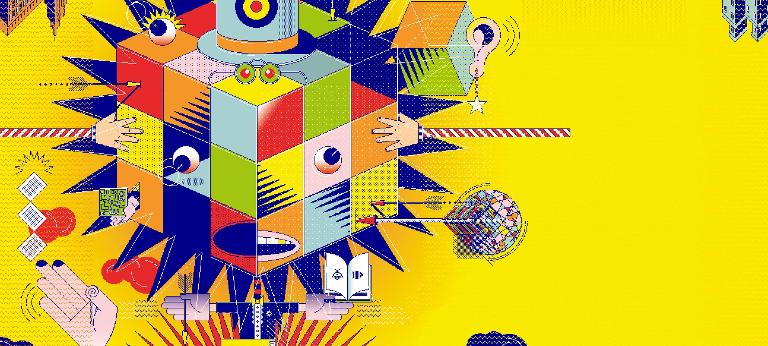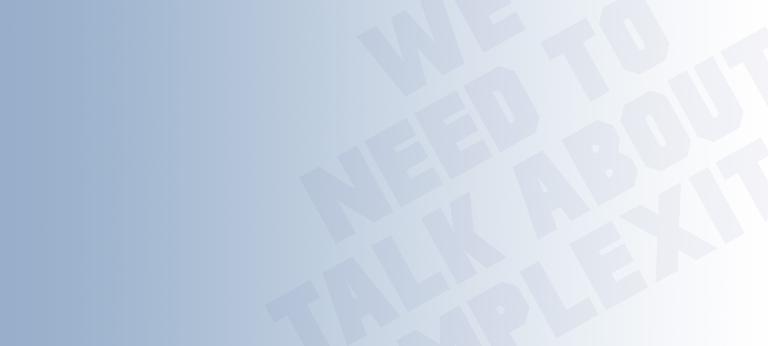Exploring complexity
![{[downloads[language].preview]}](https://www.rolandberger.com/publications/publication_image/roland_berger_think_act_magazine_navigating_complexity_cover_en_download_preview.jpg)
Don't miss our article with Nobel Prize winner Richard Thaler, as well as much more food for thought.


by Bennett Voyles
illustrations by Mark Von Ulrich
Fake news, ransomware, disruptive competition: The list of things that can go wrong for a company seems to get longer all the time. But in a global economy, fortunately so does the number of things that can go right. Can you spot the key trends in time to act on them? In this highly unpredictable era, how do you make sure you are getting the information you need to identify the facts that matter the most?
Today, Marvel entertainment, a subsidiary of The Walt Disney Company, is indeed a marvel of consumer entertainment and the home of some of the world's most valuable entertainment franchises, including Spider-Man and X-Men. But when Peter Cuneo arrived as CEO in 1999, it was a floundering comic book company just coming out of bankruptcy. If Cuneo had been Wonder Woman, he might have used his magic lasso to make his team tell the truth. If he were the Hulk, he could have cracked the conference table in two and gotten some cooperation right away. Lacking any such special powers, the executive realized he did have one superheroic advantage up his sleeve: He knew how to ask for help.
"When you as a leader are in unfamiliar territory – by that I mean, you're in an industry you don't know, or there's new technology that you're not an expert in... don't hesitate to find people who know what they're talking about," advises Cuneo. "I've been privileged to be associated with many great mentors in my career, in the military and in business, and all of them were completely devoted to finding world-class help when they needed it," says Cuneo, whose leadership career began on a US missile ship during the Vietnam War and included the successful turnaround of seven businesses, including such household names as Remington as well as divisions of Clairol and Black+Decker. And, of course, Marvel Entertainment.
"When you as a leader are in unfamiliar territory… find people who know what they're talking about."
Admitting the gaps in your knowledge might seem like common sense, but Cuneo says it's not universal. "Sometimes we see leaders who are insecure and are resistant to demonstrating the fact that they don't have the in-depth knowledge that they need for a particular challenge," says Cuneo, who is now the chairman of Cuneo & Co LLC, a firm that invests in venture capital opportunities in consumer, media and entertainment businesses. Ignorance – intelligently deployed – can even be an advantage. "When I came to Marvel, I had no background in motion pictures," recalls Cuneo. "I loved movies, but knew nothing about the practicalities of making films and knew nothing about publishing comic books. I think that was actually a benefit…. Marvel required a group of people who took a very fresh look at how business was conducted and asked the question, ‘Why do we do that? Why do we do this?'"
Whenever possible, Cuneo says, look for straight-talkers. "Try to attract people who you think will be very straightforward and direct," he says. "One of the conditions that adds complexity for a CEO occurs when you have key people who are afraid to talk candidly to you about how they feel." To encourage people who aren't naturally open to engage in honest conversation, he tries to set an example by being very candid with everyone himself. "Try to be very direct – let people know what you think the challenges and issues are, make sure everybody understands that there are no subtleties. You have to communicate regularly and consistently, or the organization is going to get confused." he says.
He also makes a habit of not shooting the messenger. "I tell people, I'm not worried about problems…. What I worry about are the situations that I don't know about," Cuneo says. "Always encourage people to expose their problems and make asking for help part of the culture of your business."
"Transference of real thought is not the same in every culture."
Paul J. Siegenthaler, a London-based executive who specializes in assisting corporate transitions, also starts every engagement by talking to people. "It's all about listening skills, asking open questions and capturing not only what the individuals answer, but also thinking beyond the words to capture what they are saying," he says. "Then dig through the layers of the organization, downwards, to detect any disconnect between the thinking of the senior management and what people perceive below them."
But don't stop at middle management: "The CEO of Coca-Cola, the CEO of PepsiCo, all these people, always, in a regular disciplined way, interact with the customers and with the frontline employees. So they get a very good feel for what is happening in addition to the information that comes from the information systems," says Ram Charan, a celebrated executive coach, advisor to many Fortune 500 companies and CEOs and author of 25 books on business. At the same time, executive coach Carol Kivler advises that you shouldn't listen to every rumor you hear. "If somebody starts to give information on somebody else, shut that down... third-party information – you can get into a lot of trouble with that."
The second challenge is making sure you understand what you've heard, which is not always easy, even if people share a common language. "One assumes there is a clear and transparent understanding when in fact, depending on one's cultural background, the same words can mean something quite different," says Siegenthaler. "The Americans have many famous jokes regarding what the British say and what they actually mean." He suggests getting around this problem by probing more deeply. "My way of finding out what is hidden behind the spoken words is to ask the respondents to illustrate their statements with a few examples that give more tangible meaning to statements – a short story or scenario gives a clearer illustration or definition of the issue the responder is trying to discuss," he says.
"Transference of real thought is not the same in every culture," agrees Charan. "You've got to build trust, you've got to listen more intently and when you get the idea from the other person, you've got to verify it. Go slow – don't go fast – and connect." Charan recommends a technique he calls "crystallizing" – concisely summarizing what the other person has just said. "It's a 100% learned skill," he says. "If you are working in a company and you have a boss or colleagues who do that, you will learn very quickly how to do that... you can pick it up in four or five weeks."
Of course, it's important to keep in mind that the difficulty in making the connection may not lie with the other person: Of the 11 million pieces of information our brain receives every second, we are only conscious of approximately 40 items. "All of us have preconceptions about people based on their social and ethnic background, and those impressions influence how we respond. We can't help it," says Sara Taylor, author of Filter Shift: How Effective People See the World. We aren't doomed to misunderstand, however. Taylor says it takes eight or nine hours to learn how to "filter shift" – that is, to compensate for the unconscious filters that may be preventing you from fully understanding a person with a different background, and to be aware when the same thing is being done to you.
In other situations, however, the subconscious can be a powerful tool for better decision-making. A Dutch-American research team conducted experiments in 2008 in which they found that people tended to make better decisions about complex problems when they didn't have very much time for reflecting on the particulars. Loran Nordgren, part of that team and an associate professor of management and organizations at the Kellogg School of Business at Northwestern University, likens conscious thought to a spotlight that is narrowly focused on one aspect of a problem. Unconscious thought, on the other hand, "is more like a child's night light, casting a dim light on the entire decision space without focusing on any one particular thing."
Gerd Gigerenzer, director at the Max Planck Institute for Human Development, director of the Harding Center for Risk Literacy in Berlin and author of Risk Savvy: How to Make Good Decisions, also advises trusting your gut instinct, if the decision is in a field that you know well. Not acting on your intuition can be expensive: Gigerenzer has surveyed managers who said that as many as two out of three decisions they made were defensive. That is, they chose the path that carried the least personal risk, not the one they believed to be best for the company. This kind of behavior tends to be particularly prevalent in organizations with a negative error culture, according to Gigerenzer. A positive error culture openly acknowledges mistakes and adjusts the system to ensure that they don't happen again. In a negative error culture, however, mistakes should never be made. As a result, when mistakes are made, they stay hidden, and the problems remain uncorrected. How do you know whether you're working for a positive or negative error culture? If you speak on the subject and the audience greets you with a deafening silence, Gigerenzer says, you are probably working in the negative kind.
Sometimes, complexity is used as a kind of camouflage to avoid coping with reality. "In many companies that are lost and troubled, you'll find positions whose responsibilities turn out to be nothing more than taking data in one form, transforming it into another form, and distributing it. This does nothing in terms of enhancing decision-making in the company," Cuneo says. "Very often the reporting of complex and useless data will bog down the company as opposed to helping. In one of the turnarounds I was involved in, there was a large report generated by the IT department every week. It went to about 50 people in the company, and I was very skeptical that this report was just taking time and a lot of people's attention, but was not actionable. So I asked the IT department one week: 'Don't put the report out, and let's see how many people ask for it, because they're the people that actually need it.' Believe it or not, out of about 50 people, only three requested it. So you have to use some common sense."
Of course, even common sense should be questioned once in a while. George Soros, the financier, has claimed that he owes his life and fortune to a family talent for seeing a gap between what people generally believed and the actual truth, whether that was as a Jewish teenager in Budapest during the Second World War whose father understood early on just how murderous the Nazis were likely to be, or later on in life when his talent for arbitrage reportedly made him a billion dollars shorting an overvalued British pound in 1992. Soros codified his ideas at the London School of Economics in the 1950s, where he studied with Karl Popper, a Viennese-born philosopher who argued that because empirical truth cannot be known with absolute certainty, ideologies that claim to possess ultimate truth must always resort to force to enforce their claim. Soros found this idea very attractive – and saw the potential for a profitable corollary in modern economic theory.
This led Soros to reflexivity, a philosophy that has guided his entire career and which can be boiled down to two propositions: First, that the participants' view of the world is always partial and distorted, and second, that those distorted views can influence the situation to which they relate because false views lead to inappropriate responses. Marx and Freud both tried and failed to show a fixed relationship between participants' thinking and the actual state of affairs, says Soros. Similarly, economics "started out by assuming perfect knowledge and, when that assumption turned out to be untenable, it went through ever increasing contortions to maintain the fiction of rational behavior," he says. "Economic theory should not be expected to produce universally valid laws that can be used reversibly to explain and predict historic events," Soros continues.
Steven Bosworth, an economist at the Kiel Institute for the World Economy, explains it this way: "I think the core idea is that all economic decisions have a social component, i.e., in standard economic theory the individual decisions are aggregated to derive the social outcomes but reflexivity recognizes that the individual's decisions are themselves a product of the aggregate outcome. The application to financial markets is clear: People will buy what they expect others to buy and sell what they expect others to sell, and this generates feedback loops, which drive booms and busts." In retrospect, this seems sensible enough, but from the crash of 1987 to the financial crisis of 2007, investors lost trillions of dollars in meltdown after meltdown precisely because they saw physics where Soros saw frenzy. Fortunately, as credit analyst Ann Rutledge notes (see box p.18), it's possible to look at numbers critically, even without a Ph.D.
Other risk experts argue that, in a world of deep uncertainty, the best defense is radical simplicity. Richard Bookstaber, risk manager of the University of California's $100 billion investment portfolio and whose background includes stints in the Treasury Department during the Obama Administration and senior positions at several major hedge funds, argues that it pays not to define potential problems too narrowly. The question that executives should be asking themselves is "if they are being too fine-tuned to the current environment, optimizing in a very fine way, relying too much on the data of the current world," Bookstaber suggests. "If they are, they might find themselves doing very well now, but out to sea if the world changes in an unexpected way. And while mechanical systems – robots producing goods, self-driving cars – can use big data, a long-term model of human interactions and experience cannot. Long-term survival requires being somewhat of a generalist."
"Act like a cockroach!" Bookstaber concludes, quoting his book The End of Theory: Financial Crises, the Failure of Economics, and the Sweep of Human Interaction. For 300 million years, he notes, the humble roach has survived transitions from jungle to desert, flatlands to cities and seen many predators come and go, all thanks "to a singularly basic and seemingly suboptimal mechanism: The cockroach simply scurries away when little hairs on its legs vibrate from puffs of air, puffs that might signal an approaching predator...." Remarkably, those little hairs have always done the job: The cockroach doesn't hear, it doesn't see, it doesn't smell. It seems to ignore a wide set of information about the environment that you would think an optimal system would take into account. The cockroach would never win the "Best Designed Bug Award" in any one environment, but it does "good enough" and makes it to the finish line in all of them.


![{[downloads[language].preview]}](https://www.rolandberger.com/publications/publication_image/roland_berger_think_act_magazine_navigating_complexity_cover_en_download_preview.jpg)
Don't miss our article with Nobel Prize winner Richard Thaler, as well as much more food for thought.
Curious about the contents of our newest Think:Act magazine? Receive your very own copy by signing up now! Subscribe here to receive our Think:Act magazine and the latest news from Roland Berger.
